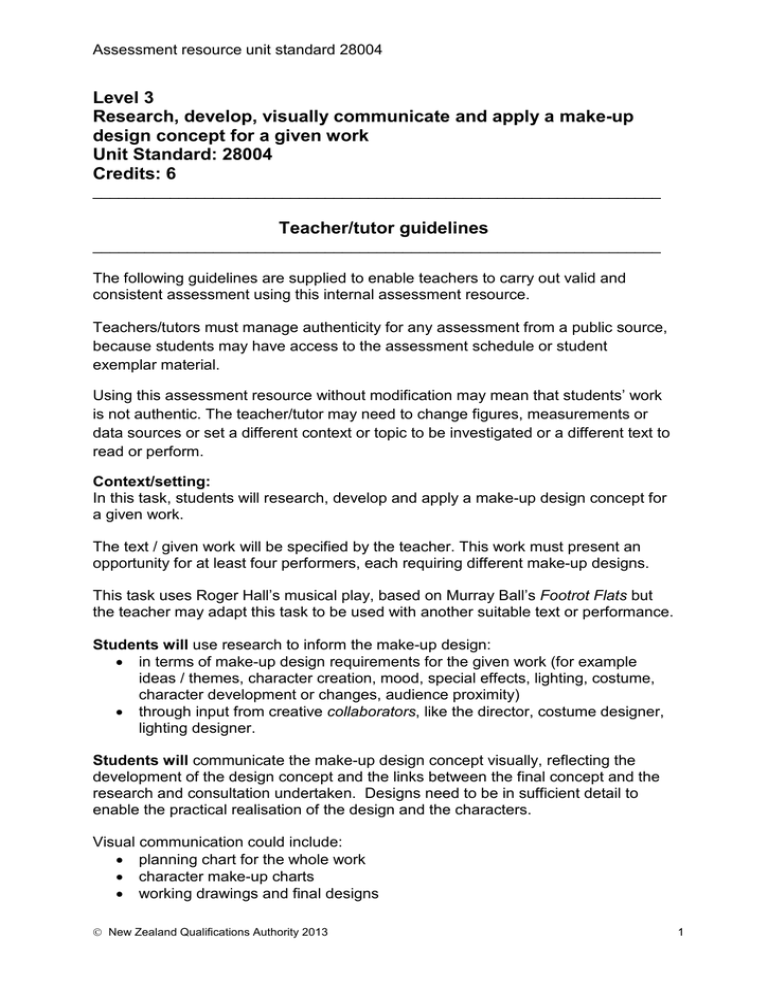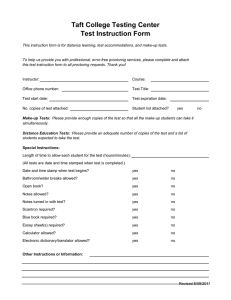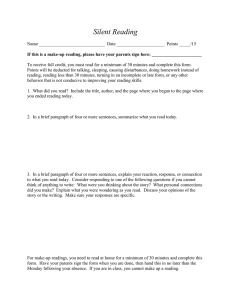Teacher guidelines
advertisement

Assessment resource unit standard 28004 Level 3 Research, develop, visually communicate and apply a make-up design concept for a given work Unit Standard: 28004 Credits: 6 __________________________________________________________________ Teacher/tutor guidelines __________________________________________________________________ The following guidelines are supplied to enable teachers to carry out valid and consistent assessment using this internal assessment resource. Teachers/tutors must manage authenticity for any assessment from a public source, because students may have access to the assessment schedule or student exemplar material. Using this assessment resource without modification may mean that students’ work is not authentic. The teacher/tutor may need to change figures, measurements or data sources or set a different context or topic to be investigated or a different text to read or perform. Context/setting: In this task, students will research, develop and apply a make-up design concept for a given work. The text / given work will be specified by the teacher. This work must present an opportunity for at least four performers, each requiring different make-up designs. This task uses Roger Hall’s musical play, based on Murray Ball’s Footrot Flats but the teacher may adapt this task to be used with another suitable text or performance. Students will use research to inform the make-up design: • in terms of make-up design requirements for the given work (for example ideas / themes, character creation, mood, special effects, lighting, costume, character development or changes, audience proximity) • through input from creative collaborators, like the director, costume designer, lighting designer. Students will communicate the make-up design concept visually, reflecting the development of the design concept and the links between the final concept and the research and consultation undertaken. Designs need to be in sufficient detail to enable the practical realisation of the design and the characters. Visual communication could include: • planning chart for the whole work • character make-up charts • working drawings and final designs New Zealand Qualifications Authority 2013 1 Assessment resource unit standard 28004 • • • • • annotated sketches / templates journal multi-media presentation (2D or 3D) products and techniques required close-ups, special effects, colour and texture indications. Students will select suitable make-up products and apply these to realise their make-up designs on four performers. Students must demonstrate safe working practices at all times. This may include safe hygiene practices, replacing, cleaning and storing equipment, use of tools, following manufacturer's instructions. This task is ideally suited to be used as an option, amongst others, for one or two students to work on as a part of a school or class production. Other students would be working on set design, costume, lighting, directing and acting for the same production. Over the weeks prior to this assessment, students should have had sufficient teaching and learning opportunities to develop their understanding of • the given work, (in this case a production of Roger Hall’s musical play, based on Murray Ball’s Footrot Flats), • what a production concept is, • the design elements of shape, line, colour, texture and contrast, • make-up techniques of enhancement, concealing or correction, aging, changing features, special effects etc and how these might translate into make-up design. Students who have successfully completed the requirements for assessment for Units 26688, Demonstrate knowledge and techniques of make-up application for a performance context, and 27701, Demonstrate knowledge and skills of make-up design and application for a specified character, should have the requisite prior knowledge required. If students have not completed these units, teachers may have to cover this in pre-teaching. Award of Grades • For award with Achieved, the outcome must be achieved as specified in the outcome statement. • For Merit, in researching, developing, visually communicating and applying a make-up design concept for a given work, the candidate: o describes the links between the given work, and their make-up design o concept; o refines their make-up design concept by considering and incorporating feedback from a creative collaborator(s); o demonstrates creativity in visually communicating their make-up design concept; o demonstrates skilful technique in applying the make-up design concept to the performers in the given work. New Zealand Qualifications Authority 2013 2 Assessment resource unit standard 28004 • For Excellence, in researching, developing, visually communicating and applying a make-up design concept for a given work, the candidate: o justifies the links between the given work and their make-up design; o refines their make-up design concept by evaluating and incorporating feedback from a creative collaborator(s); o demonstrates creativity and originality in visually communicating their makeup design concept; o demonstrates command of technique in applying the make-up design concept to the performers in the given work. Assessment activity: This assessment activity has four tasks. Task one involves the student researching make-up requirements of the given text, Roger Hall’s musical play, based on Murray Ball’s Footrot Flats. Evidence of this can be collected via written, visual or oral methods such as a video diary, annotated sketches, diagrams, or written description. Task two involves the student collaborating with director, costume designer, lighting designer on both the overall production concept and the design concept for the production. This collaboration could involve contributing to the development of the production and design concepts, and/or discussing how the production and design concepts would inform the make-up design. Students should work closely with the costume designer, specially. Evidence of this collaboration and discussion, along with initial design ideas, can be collected via written, visual or oral methods, as for Task one. Task three involves the student presenting their final overall make-up design concept for the musical, along with detailed make-up designs for four different characters. Evidence of this will be collected via written and visual methods such as a video diary, annotated sketches, diagrams, written description, final design drawings. Task four involves the student selecting make-up products and techniques, and using these to apply the designs to four performers. Their work should demonstrate skill and be faithful to the designs. They must demonstrate safe working practices. Evidence of this will be collected by observation, video, photographs. Conditions of assessment Assessment will be carried out as a practical assessment of understanding and skills. Student’s final product will be assessed alongside their developmental notes/journal. This may include diary entries, diagrams, ideas, brainstorms, collages, sketches, photographs, colour schemes etc. New Zealand Qualifications Authority 2013 3 Assessment resource unit standard 28004 As students develop their assessment, teachers can offer guidance that may prompt the student to further investigation and consideration of their ideas. Teachers may not correct assessment errors, or suggest specific ideas. The text used and the context the candidate is being assessed in must be specified by the teacher/tutor. Assessment can occur via group activities, however there must be evidence that each student can complete all aspects of the standard. Resource Requirements Students will need access to water based and crème make-up bases, colour palettes, eyeliner, mascara, blush, lip colours, powder, sponges, brushes and the appropriate make-up removers. Stipple, putty, bald wigs, latex, spirit gum, false hair may also be provided. Copies of the script: Footrot Flats: Book by Roger Hall, music by Philip Norman, lyrics by A K Grant, based on original characters created by Murray Ball. Available through Playmarket: http://www.playmarket.org.nz. Some suggested teaching and learning resources are: Mayer, David (ed) (1998). A Phaidon Theatre Journal: Costume and Make-up. London, Phaidon Press, Ltd. Schanker, Harry H. and Ommanney, Katherine Anne (1997). The Stage and the School. Ohio, Glencoe / McGraw-Hill. Additional information Candidates being assessed against this unit standard must demonstrate safe working practices at all times. These may include – safe hygiene practices; replacing, cleaning and storing products and equipment; safe use of tools, following manufacturer's instructions. Evidence of this may be provided by, for example, a teacher/tutor attestation or candidate’s reflective statement. A useful reference for safe working practice is the Ministry of Business, Innovation and Employment publication A Guide for Safe Working Practices in the New Zealand Theatre and Entertainment Industry, 2007, which can be accessed at: http://www.osh.govt.nz/order/catalogue/. New Zealand Qualifications Authority 2013 4


